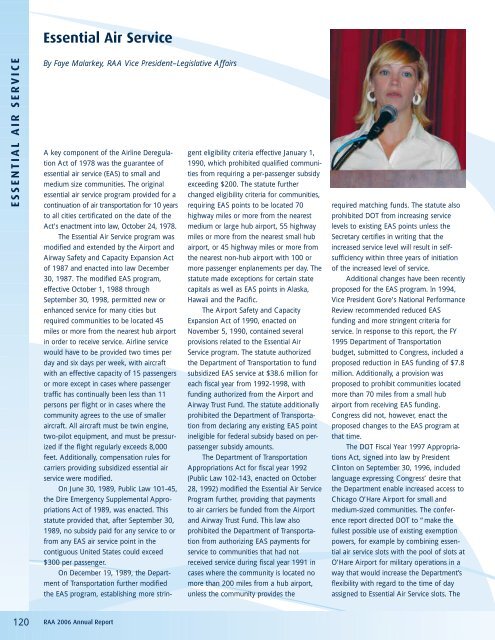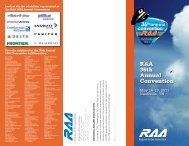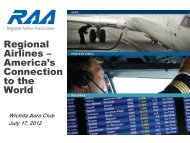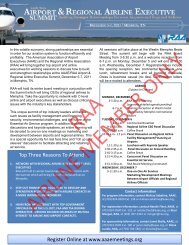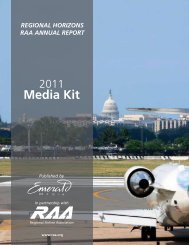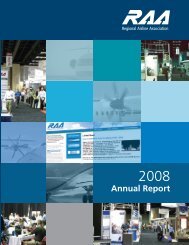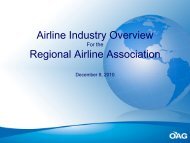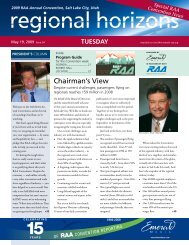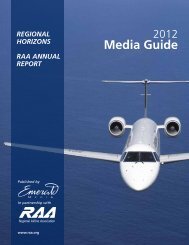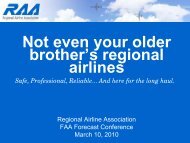Right time. - Regional Airline Association
Right time. - Regional Airline Association
Right time. - Regional Airline Association
Create successful ePaper yourself
Turn your PDF publications into a flip-book with our unique Google optimized e-Paper software.
ESSENTIAL AIR SERVICE<br />
120<br />
Essential Air Service<br />
By Faye Malarkey, RAA Vice President–Legislative Affairs<br />
A key component of the <strong>Airline</strong> Deregulation<br />
Act of 1978 was the guarantee of<br />
essential air service (EAS) to small and<br />
medium size communities. The original<br />
essential air service program provided for a<br />
continuation of air transportation for 10 years<br />
to all cities certificated on the date of the<br />
Act's enactment into law, October 24, 1978.<br />
The Essential Air Service program was<br />
modified and extended by the Airport and<br />
Airway Safety and Capacity Expansion Act<br />
of 1987 and enacted into law December<br />
30, 1987. The modified EAS program,<br />
effective October 1, 1988 through<br />
September 30, 1998, permitted new or<br />
enhanced service for many cities but<br />
required communities to be located 45<br />
miles or more from the nearest hub airport<br />
in order to receive service. <strong>Airline</strong> service<br />
would have to be provided two <strong>time</strong>s per<br />
day and six days per week, with aircraft<br />
with an effective capacity of 15 passengers<br />
or more except in cases where passenger<br />
traffic has continually been less than 11<br />
persons per flight or in cases where the<br />
community agrees to the use of smaller<br />
aircraft. All aircraft must be twin engine,<br />
two-pilot equipment, and must be pressurized<br />
if the flight regularly exceeds 8,000<br />
feet. Additionally, compensation rules for<br />
carriers providing subsidized essential air<br />
service were modified.<br />
On June 30, 1989, Public Law 101-45,<br />
the Dire Emergency Supplemental Appropriations<br />
Act of 1989, was enacted. This<br />
statute provided that, after September 30,<br />
1989, no subsidy paid for any service to or<br />
from any EAS air service point in the<br />
contiguous United States could exceed<br />
$300 per passenger.<br />
On December 19, 1989, the Department<br />
of Transportation further modified<br />
the EAS program, establishing more strin-<br />
RAA 2006 Annual Report<br />
gent eligibility criteria effective January 1,<br />
1990, which prohibited qualified communities<br />
from requiring a per-passenger subsidy<br />
exceeding $200. The statute further<br />
changed eligibility criteria for communities,<br />
requiring EAS points to be located 70<br />
highway miles or more from the nearest<br />
medium or large hub airport, 55 highway<br />
miles or more from the nearest small hub<br />
airport, or 45 highway miles or more from<br />
the nearest non-hub airport with 100 or<br />
more passenger enplanements per day. The<br />
statute made exceptions for certain state<br />
capitals as well as EAS points in Alaska,<br />
Hawaii and the Pacific.<br />
The Airport Safety and Capacity<br />
Expansion Act of 1990, enacted on<br />
November 5, 1990, contained several<br />
provisions related to the Essential Air<br />
Service program. The statute authorized<br />
the Department of Transportation to fund<br />
subsidized EAS service at $38.6 million for<br />
each fiscal year from 1992-1998, with<br />
funding authorized from the Airport and<br />
Airway Trust Fund. The statute additionally<br />
prohibited the Department of Transportation<br />
from declaring any existing EAS point<br />
ineligible for federal subsidy based on perpassenger<br />
subsidy amounts.<br />
The Department of Transportation<br />
Appropriations Act for fiscal year 1992<br />
(Public Law 102-143, enacted on October<br />
28, 1992) modified the Essential Air Service<br />
Program further, providing that payments<br />
to air carriers be funded from the Airport<br />
and Airway Trust Fund. This law also<br />
prohibited the Department of Transportation<br />
from authorizing EAS payments for<br />
service to communities that had not<br />
received service during fiscal year 1991 in<br />
cases where the community is located no<br />
more than 200 miles from a hub airport,<br />
unless the community provides the<br />
required matching funds. The statute also<br />
prohibited DOT from increasing service<br />
levels to existing EAS points unless the<br />
Secretary certifies in writing that the<br />
increased service level will result in selfsufficiency<br />
within three years of initiation<br />
of the increased level of service.<br />
Additional changes have been recently<br />
proposed for the EAS program. In 1994,<br />
Vice President Gore's National Performance<br />
Review recommended reduced EAS<br />
funding and more stringent criteria for<br />
service. In response to this report, the FY<br />
1995 Department of Transportation<br />
budget, submitted to Congress, included a<br />
proposed reduction in EAS funding of $7.8<br />
million. Additionally, a provision was<br />
proposed to prohibit communities located<br />
more than 70 miles from a small hub<br />
airport from receiving EAS funding.<br />
Congress did not, however, enact the<br />
proposed changes to the EAS program at<br />
that <strong>time</strong>.<br />
The DOT Fiscal Year 1997 Appropriations<br />
Act, signed into law by President<br />
Clinton on September 30, 1996, included<br />
language expressing Congress’ desire that<br />
the Department enable increased access to<br />
Chicago O’Hare Airport for small and<br />
medium-sized communities. The conference<br />
report directed DOT to “make the<br />
fullest possible use of existing exemption<br />
powers, for example by combining essential<br />
air service slots with the pool of slots at<br />
O’Hare Airport for military operations in a<br />
way that would increase the Department’s<br />
flexibility with regard to the <strong>time</strong> of day<br />
assigned to Essential Air Service slots. The


